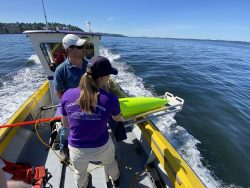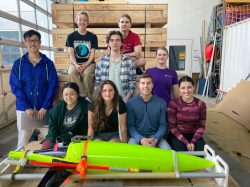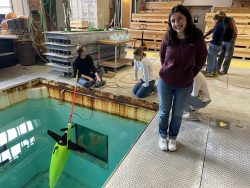
In spring of 2023, University of Washington undergraduates loaded a curious-looking, brightly-colored machine onto a boat and headed out into Puget Sound. The machine, an autonomous underwater vehicle known as a Seaglider, looked like a cross between a torpedo and a rocket ship, and would be tasked with collecting a variety of important data about our oceans. What’s more, this particular launch would represent the first successful deployment of a Seaglider by UW students.
“It was the first time the glider was not just sitting on the table in the lab, but was going out to collect data,” said UW undergraduate Layla Airola. Airola, along with about 15 other UW undergraduate students, is a member of the Student Seaglider Center, a student-run laboratory within the School of Oceanography that gives students hands-on opportunities to conduct oceanographic research with these unique instruments. The program, now in its second year, brings together students from multiple disciplinary backgrounds and continues to grow.
What is a Seaglider?
Seagliders are used to collect a variety of data that can often be expensive or difficult for scientists to collect with other instruments, and are programmed to dive up and down the water column up to 1,000 meters below the surface. They can take measurements of dissolved oxygen, water pressure, temperature, salinity, backscatter and chlorophyll concentrations for months at a time without human intervention. These real-time data are then transmitted to researchers via a satellite connection, and have been used to monitor changes in our oceans over time — and have even aided in tracking the spread of oil through the water column after oil spills.

A scrappy approach
In 2005, affiliate professor of oceanography Fritz Stahr established the UW Seaglider Fabrication Center, which developed and produced the vehicles until 2018. After the lab ceased operations, the UW Applied Physics Laboratory still had several gliders on hand that wound up sitting in storage for a number of years. School of Oceanography research scientist Rick Rupan and lecturer Sasha Seroy organized a group of students to help refurbish the abandoned Seagliders — and thus, the Student Seaglider Center was born in 2022.
The center has garnered interest from students across disciplines at UW — Airola, for example, plans to pursue a business degree, while other students involved bring physics, oceanography, programming and engineering backgrounds to the program. Opening the center to all students has had its advantages, as the program initially faced challenges sourcing funding. Bringing her skills to the team, Airola successfully spearheaded a grant proposal that aided students in purchasing the parts needed to build and repair the Seagliders.
Last year, the students worked with one goal in mind: to launch a Seaglider successfully before the center’s seniors graduated. As they set off into Puget Sound last spring for the launch, they knew it was thanks to their interdisciplinary approach and diverse set of strengths.

Gliding into the future
This year, the students hope to build on their success and deploy more Seagliders, with the potential for multiple-day deployments in different locations. They also hope to collect and analyze their own data for the first time. But their projects are always evolving.
“We had the main goal of deploying the Seagliders last spring, but along the way there were lots of other goals that involved many different people and parts,” Airola said.
It can be challenging for undergraduate students to find hands-on experiences with the most advanced technologies in their fields, but the Student Seaglider Center offers a space where collaboration and experiential learning go hand in hand.
Story by Ellie Mason

